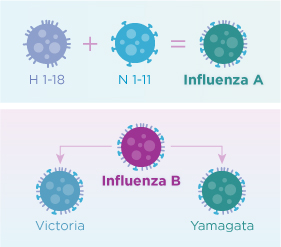
- Flu Facts
What Are the Different Types of Influenza Viruses?

Some people may think influenza (flu) is just a standard virus that comes around every year. But there are actually four different types of flu viruses, including A, B, C, and D.
Influenza A: Influenza A viruses can be found in many different animals, including birds and mammals, as well as humans. These viruses are characterized by surface proteins, including hemagglutinin (“H”) and neuraminidase (“N”). These viruses are further separated into subtypes by number. There are 18 different H subtypes and 11 different N subtypes, and 131 subtype combinations have been detected in nature. Examples of flu viruses in this category include H1N1 and H3N2.

Influenza B: These viruses only affect people and are characterized according to where the virus was originally isolated. The two main categories (lineages) of influenza B include B/Yamagata and B/Victoria.
Influenza C: This type of flu can affect people, but most often only causes mild illness. Influenza C infections are not thought to cause human flu epidemics, which are defined as widespread flu illness in a localized area.
Influenza D: This type of flu primarily affects cattle and is not known to affect people.
How can flu viruses change?
Flu viruses are constantly changing, which is why flu vaccine composition changes every year to match the circulating strains. Flu viruses can change slightly (know as “antigenic drift”) or rapidly (known as “antigenic shift”). Antigenic drift refers to small changes in the genetic make-up of flu viruses that can lead to changes in the surface proteins (hemagglutinin and neuraminidase). Antigenic shift refers to an abrupt, major change in an influenza A virus, resulting in new surface proteins that can infect humans.
Flu viruses are constantly changing, which is why flu vaccine composition changes every year to match the circulating strains.
What’s the difference between “seasonal flu” and “pandemic flu”?
Influenza A and B viruses affect people and cause what is commonly referred to as “seasonal flu”, which occurs every year. Influenza A also has pandemic potential, meaning that new (novel) influenza A viruses can emerge and cause a pandemic, defined as a global outbreak. For a pandemic to occur, the new virus has to be able to infect people easily and spread efficiently from person to person. There have been four flu pandemics in the past 100 years.
How are flu strains selected for annual flu vaccines?
There are over 100 centers in the world that conduct year-round, global surveillance on circulating flu strains. These laboratories send representative flu virus samples to five collaborating World Health Organization (WHO) centers located in the United States, United Kingdom, Australia, Japan, and China. Using this information, the WHO then recommends flu vaccine composition twice a year: once in February for the upcoming season in the Northern Hemisphere and a second time in September for the upcoming season in the Southern Hemisphere. Following WHO’s recommendations, each country then makes their own decision about which flu strains to include in the annual vaccine. In the U.S., this decision is made by the Food and Drug Administration (FDA). Annual flu vaccines are designed to protect against three or four different flu strains, including influenza A and B types.
Sources:


